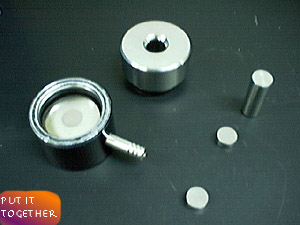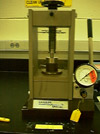Solid Sample Preparation
One way to prepare the solid sample is to grind it into a fine powder and
then mix in approximately one milligram of the sample with about 100 milligrams
of potassium bromide (KBr). Potassium bromide is usable to around 400 cm-1,
where it will start to interfere with the absorbence (active bonds below
400 cm-1). Potassium bromide forms a clear plate when it is
put under pressure, if the ideal amount is put into the pressure vessel.
 Before
the sample can be pressurized it must be put into a vessel that can stand
the pressure that is going to be applied. The picture to the left tells
the tale of the pieces that go together to complete the vessel and what
it looks like when the final vessel is together.
Before
the sample can be pressurized it must be put into a vessel that can stand
the pressure that is going to be applied. The picture to the left tells
the tale of the pieces that go together to complete the vessel and what
it looks like when the final vessel is together.
 After
you mix and crush your sample thoroughly and put some of it into the vessel,
it is ready to be put under pressure. This apparatus on the right is what
you will use to apply pressure to the sample. It pushes the crystals into
one thin-layer crystal when the handle is pulled like a slot machine. It
is important to observe the red warning on this apparatus and not apply
more pressure than recommended. My Jeep's odometer says that I can apply
9000 rpm to the engine. However, if I go over 2500-3000 rpm pieces might start
to dangerously fly through the hood. Likewise with this apparatus. The
amount of pressure allowed is more than enough to create your plate.
After
you mix and crush your sample thoroughly and put some of it into the vessel,
it is ready to be put under pressure. This apparatus on the right is what
you will use to apply pressure to the sample. It pushes the crystals into
one thin-layer crystal when the handle is pulled like a slot machine. It
is important to observe the red warning on this apparatus and not apply
more pressure than recommended. My Jeep's odometer says that I can apply
9000 rpm to the engine. However, if I go over 2500-3000 rpm pieces might start
to dangerously fly through the hood. Likewise with this apparatus. The
amount of pressure allowed is more than enough to create your plate.
Finally, you have your plate and are ready to take
a spectrum. Ideally, your plate should be completely clear so that
the only absorbtion is that of the bonds of the molecule instead of light
not getting through.
Back to sample preparation.
 Before
the sample can be pressurized it must be put into a vessel that can stand
the pressure that is going to be applied. The picture to the left tells
the tale of the pieces that go together to complete the vessel and what
it looks like when the final vessel is together.
Before
the sample can be pressurized it must be put into a vessel that can stand
the pressure that is going to be applied. The picture to the left tells
the tale of the pieces that go together to complete the vessel and what
it looks like when the final vessel is together.
